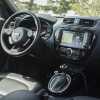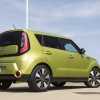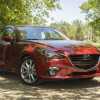With 2014 coming to a close and your's truly still having a number of vehicles that need to have reviews written up, I thought it would be a good idea to finish up the year with the remaining vehicles from the 2014 model year. Over the next few weeks, I'll be posting a number of quick reviews. This will be leading up to my favorite vehicles I drove in the past year.
Let's begin with the smallest vehicles that I reviewed: subcompacts and compacts.
First Up: 2015 Honda Fit EX
If there was one model that defined the current subcompact class, it would have to be the Honda Fit. When it was first introduced back in 2006, the Fit featured a clever back seat to increase the practicality of the vehicle; impressive driving dynamics, and sipping fuel like no other. Now the subcompact field has grown in terms of quantity and quality of vehicles. Honda has responded by introducing the third-generation Fit this year. How does the new Fit stand up to the new crowd?
The Fit retains the shape it has for the past two-generations, but it gets a bit more aggressive and sleeker. The front looks like Honda’s designers watched a bit too much of Iron Man with the solid one piece grille. Other items of note on the front include larger air ducts and slimmer headlights. The side profile boasts two character lines to help give it an identity. Around back are a set of tall taillights and a set of faux vents in the bumper.
Stepping inside the Fit, Honda has reworked the dashboard layout with controls for the radio and climate control system angled towards the driver. Material quality has seen a noticeable improvement with soft-touch materials and faux aluminum trim used throughout. The touchscreen radio is easy to use and quick to respond. The big downside is Honda deciding use capacitive-touch buttons for volume and home. There were times when I had to hit the volume button more than once to get it to respond. Honda, please go back to normal buttons and knobs.Even though the new Fit is about 1.6 inches shorter than the previous model, Honda was able to increase passenger space by 4.9 cubic feet. This is due to a longer wheelbase and a thinner, center-mounted gas tank. Sitting in the back. I found more than enough head and legroom. Now the increase in passenger space means cargo space has dropped by about 4 cubic feet. Still, the Fit cargo’s space is impressive with 17 cubic feet with the rear seats up and 53 cubic feet with the seats down.
The back seat is also one of the most versatile I have ever come across in a vehicle. The Fit’s ‘Magic’ seat can be set up in four different ways to provide added functionality. Those include:
- Folding the rear seats down to create more space
- Folding one part of rear seats (60/40 split) to make room for cargo, while retaining some seat space for a passenger
- Folding the seat bottoms up to carry tall items
- Folding the front seats back to create a sudo-bed
Power comes from a 1.5L EarthDreams four-cylinder with 130 horsepower and 114 pound-feet of torque. In my tester, the engine was paired up to a CVT. The engine has to be worked to get up to speed which is normal for this type of car. What I’m not so happy with is the amount of buzzy-ness that is coming from the engine. Honda has said they have worked on trying to improve NVH levels in the Fit, though I find that hard to believe due to the amount of engine noise in the cabin. Thankfully, the powertrain does quiet down when you settle into speed. The CVT does behave nicely and doesn’t have the whine that most transmissions of this type are known for till you get higher in the revs. Fuel economy wise, the Fit with the CVT is rated by the EPA at 33 City/41 Highway/36 Combined. My week saw an overall average of 38 MPG. I should note that I did see 40 MPG when I took the Fit on a trip to Northern Michigan.
The Fit earned a reputation for being a fun to drive subcompact, and for the most part that still holds true. It feels playful when going through the curvy bits and the chassis keeps the car grounded. The steering is a bit too light, and it doesn’t have quite the feel that the last generation model was known for. But what surprised me is how Fit did on a long drive. Being a subcompact, I thought the Fit would be uncomfortable due to its short wheelbase. But Honda has made some improvements to the suspension to make it more comfortable for long trips. This means the Fit was able to deal with bumps and imperfections without having any of the passengers feeling it. After doing a drive to Northern Michigan, I had no aches or pain when I got out of the Fit.
The Honda Fit still stands tall in the subcompact class with its impressive versatility, fuel economy, and driving dynamics. Hopefully Honda has plans in the works for improving the NVH levels in the engine. Otherwise, the Fit is worth a look if you’re shopping for a new subcompact.
Disclaimer: Honda Provided the Fit EX, Insurance, and One Tank of Gas
Year: 2015
Make: Honda
Model: Fit
Trim: EX
Engine: 1.5L 16-Valve DOHC i-VTEC four-cylinder
Driveline: Front-Wheel Drive, CVT
Horsepower @ RPM: 130 @ 6600
Torque @ RPM: 114 @ 4600
Fuel Economy: City/Highway/Combined - 33/41/36
Curb Weight: 2,630 lbs
Location of Manufacture: Yorii, Japan
Base Price: $17,560
As Tested Price: $19,180 (Includes $820.00 Destination Charge)
Options:
N/A
Next Page: 2014 Kia Soul ! (Exclaim)












-3707742431.jpg.06edf8e14f4ccf35c60d4774a543cc11.jpg)



Recommended Comments
Join the conversation
You can post now and register later. If you have an account, sign in now to post with your account.
Note: Your post will require moderator approval before it will be visible.